Planting and caring for honeysuckle honeysuckle
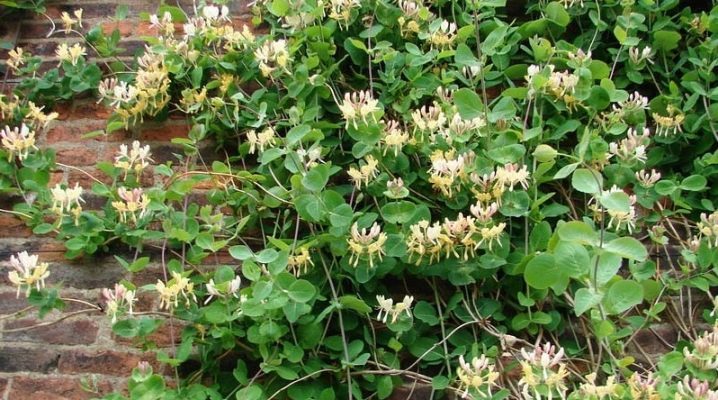
Honeysuckle is an abundantly flowering aromatic honeysuckle. In summer, the climbing shrub covers many delicate flowers. A plant planted in good conditions does not require special care. The decorative variety is characterized by sufficient frost resistance, fast growth, long flowering period and delicate aroma.
With its small size and good pruning response, honeysuckle grows well in containers on terraces and balconies. By laying the lashes in a certain direction, you can create a beautiful landscape design, braid the gazebos and delimit the adjoining space.



Where and how to plant?
The decorative Lonicera caprifolium is a popular and showy representative of its kind. She is distinguished by vigorous growth. For a short period of time, she is able to braid a five-meter-high fence. Planting honeysuckle honeysuckle is easy to handle if you know how to do it right. The culture is able to withstand even a frosty period if it takes a good position on the site. A curly liana requires a stable support, for example, in the form of a coarse mesh, a gazebo or a pergola.
You can simply use a grate attached to the wall. In this case, it is better to prefer the sunny side, since honeysuckle blooms most abundantly under direct sun. But partial shading by trees is also allowed.
It is important to remember that the ground is constantly dry near the wall, so the honeysuckle in such a place likes increased watering. Caprifoli do not like stagnant water and extremely opposite conditions - overdried sandy soil or too heavy loam.


In general, the plant has very modest requirements for the soil.
- Shows good growth on neutral and slightly alkaline soils.
- The soil must be moderately moistened, but not filled with water.
- Soil with a high humus content promotes the appearance of many flowers.
Honeysuckle is usually sold in containers. Such seedlings can be planted throughout the entire growing season, taking into account the natural, weather conditions in the growing zone. For this variety, autumn is considered an unsuitable time for planting in open ground. The best time for planting honeysuckle is spring. Like other shrubs planted in the spring, honeysuckle will need plenty of water until it takes over. At the same time, planting in the spring season reduces the risk of freezing the plant in winter. It is advisable to plant a shrub on a cloudy day, ideally immediately after rain.
It is worth adding that a plant like honeysuckle does not tolerate close proximity. Therefore, before planting, it is necessary to remove all weeds and perennial plants, weed the ground so that it receives heat and oxygen. In the absence of mulch, the soil should be weeded twice a week. Other decorative crops can be planted in the area nearby.
Honeysuckle has good compatibility with lavender. In addition, at the time of flowering, it looks incredibly impressive.


Landing progress step by step.
- Dig a hole. If you plan to place a bush against a wall, you need to dig a hole, stepping back 25-50 cm from it. If climbing plants are intended to weave a fence, they must be planted, observing an approximate interval of one meter.
- The soil will have to be thoroughly dug up, loosened, peat and compost introduced to improve moisture capacity. You can use rotted manure.
- The honeysuckle grows not only upwards, but also on the sides. Therefore, it is important for her to provide support. It is advisable to choose a rough material that has better surface adhesion properties. A fairly strong support is required that can withstand a significant load. Arches braided with honeysuckle, green gazebos, effectively decorated posts and lattice frames turn out to be incredibly beautiful. The correct growth of the bush is facilitated by its formation during the planting period. If a reliable support is not created, honeysuckle will soon lose all its visual appeal.
- Before being immersed in the pit, the roots of the seedlings must be soaked in warm water. You can use clean water or a solution of any biostimulant, even active folk remedies. Leave the seedling in the liquid for a day. Dried ends should be trimmed to living tissue.
- Moisten the soil at the bottom of the pitusing 4-5 liters per plant.
- Place the seedlings in the pits, straightening the rootsso that they do not bend upwards. They need to be placed 5-10 cm deeper than when they were growing in containers.
- Cover the hole with earth, gradually condensing it. The root collar should rise 4-5 cm above the soil level.
- Water the plant again at the rate of 8-10 liters of water and mulch the soil.
- Tie the shoots to the support. It is recommended to cover the soil with bark to minimize moisture evaporation.

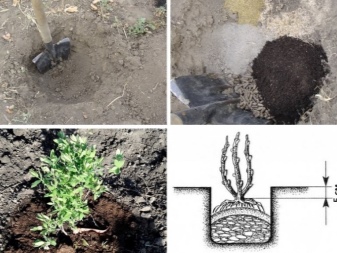
The nuances of trimming
For a year, honeysuckle grows up to 0.5-2 meters based on how fertile the soil is. If necessary, the shoots are shortened, but this is not a fundamental measure to keep the honeysuckle in a healthy and flowering form. The formation has a beneficial effect on the shrub, and it is recommended to produce it the first 2 years after the planting. In the very first spring, the emerging shoots should be shortened by 2/3 of the length.
In the second year, during spring pruning, leave up to 4 skeletal shoots, cut off the rest at ground level. At the base of old shrubs, shoots are often exposed. They need an incentive to recover. The procedure is performed once every 6 years. The oldest shoots should be cut at soil level.
So that the shrub does not weaken sharply, it is permissible to prune it in two stages, stretching the procedure for 2 years.



Transplant rules
Honeysuckle bushes grow successfully and give a generous harvest for years in the same place. Caring for the bushes gives them the opportunity not to grow and regularly delight the eye with beautiful flowers. There are not many reasons for changing the place, but they are weighty. It is required to change the location of honeysuckle in the fall:
- if the bush has grown too wide;
- the strengthened plant began to survive "neighbors";
- honeysuckle grows in a place where too little sun penetrates.
The transplant is planned taking into account the layout of the site. Only plants under 5 years of age can be transplanted. More mature bushes should not be transferred to another place. The plant can sharply throw off the foliage, get sick and die. In extreme cases, transplanting young plants in summer is permissible. It is carried out in June, not forgetting about additional watering, mulching and shading in intense heat. An adult shrub is transplanted in this way:
- trim;
- dig a small hole;
- pour fertilizers;
- gently dig in the bush;
- pull it out along with a small earthen lump;
- transfer to a prepared place;
- place in the hole, carefully spreading the roots;
- pour over the soil, building something like an earthen board around the bush;
- spill abundantly with water.
Experienced gardeners believe that it is undesirable to touch honeysuckle bushes in the spring. The period of activity of the plant falls in the spring-summer season. At the end of summer, the activity of honeysuckle stops. From this moment on, a good time comes for a honeysuckle transplant. Choosing the right time for autumn planting activities, they take into account the climate in the place where the shrub grows. In the northern regions, honeysuckle is transplanted until mid-September.Only in this variant will the bushes be able to survive and gain a foothold in a new place before the onset of winter. In warm areas, the event is scheduled for the end of October.



Watering and feeding
Honeysuckle needs regular fertilization. Every spring, the soil is loosened around the shrub, adding shredded compost. And also good results can be expected if the crop is fed with granular mineral fertilizers. They are scattered twice under the bushes:
- with the onset of vegetation (before flowering);
- during the border season, between spring and summer (but not later than the end of June).
Regular watering is also considered an important measure of caring for honeysuckle. The plant especially needs moisture in the sultry summer, when the fruits are tied. It is advisable to water the shrubs generously, but infrequently, because this is the only way the water reaches the very roots.
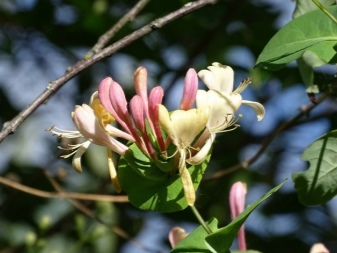

Wintering
Honeysuckle is a culture that is resistant to winter frosts. In the suburbs, planting and further care for it are not a problem. She does not have to be sheltered for the winter, she confidently tolerates winter in central Russia. An exception is made only for young shoots. At the end of November, they are placed under agrofibre. However, young shoots often freeze under cover. After winter, the shoots will have to be cut off. According to gardeners from the north of the Moscow region, it is better to cover even an adult honeysuckle in the winter season, for example, using lutrasil. Even if the honeysuckle is frozen, it will quickly sprout fresh shoots. It is better to plant a bush in a sunny place, protected from harsh winds from the north.
Before wintering, it is important to clear the trunk circle of any plant debris and cover it with a thick layer (20-25 cm) of dry foliage (straw). Shoots are removed from the support and rolled into a ring, covered with spruce branches on top and several layers of burlap or other covering material are laid.
In mild climates, the honeysuckle variety is left to winter without protective shelter. The only exceptions are plants of the first year of life after planting. With them it is worthwhile to play it safe and organize a shelter.

Diseases and pests
Treatment of diseases
Most of the difficulties in growing picturesque honeysuckle are created by the appearance of powdery mildew. At the first signs of illness, the gardener's task is to respond promptly to take measures to eradicate the infection. It usually manifests itself as a white bloom on the leaves in mid-summer. The affected area is growing rapidly. It is possible to overcome the disease with the help of biological products and fungicides with a chemical composition, such as Topsin and similar compounds. The Inga honeysuckle variety is considered the most resistant to powdery mildew. Often the disease affects plants located in partial shade, where air does not circulate. Honeysuckle can also be affected by leaf spot. In the fight against defeat, such drugs as "Discus" and "Domark" are shown. It is recommended to spray 2-3 times with an interval of 10 days, alternating preparations.
Other possible plant diseases and a description of their signs should be studied in detail. The most dangerous diseases include ramulariasis. It appears on young leaves with gray-brown spots with a brown center. As the infection develops, the stems are affected, then the petioles. The plant is weakening due to lack of nutrients. If nothing is done, honeysuckle dies off. Spraying with a solution of "Fundazol" or copper sulfate helps against ramulariasis.
Equally dangerous is cercosporosis... On the leaves, it appears as dark dots with a reddish-brown border. The methods of dealing with this disease are similar to those that are effective for ramulariasis. Honeysuckle can also be struck by the dangerous fungus tuberculariosis. It parasitizes on the branches of honeysuckle. You can recognize it by the appearance of red bumps. Spores also settle in the bark of the shrub, which leads to its wilting. The affected area must be excised and destroyed immediately. As a preventive measure, it is recommended to spray honeysuckle in spring with Bordeaux liquid and copper sulfate.
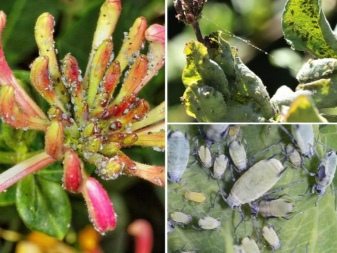
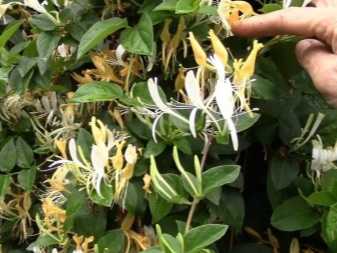
Insect control
The greatest danger to honeysuckle is aphid. Honeysuckle growing against a sunny wall on either the south or east side will eventually attract aphids. Shrubs should be checked for pests in May. The sooner it is possible to detect parasites, the easier it will be to get rid of the invasion. Aphids usually attack the tops of the shoots in late spring. She is more often attracted to plants growing in arid and sunny places. In the fight against small pests, irrigation with a strong solution of nettle (infusion) in a concentrated form is effective. To prepare the infusion, 200 g of dry grass and 1 liter of boiling water are required. With a large-scale defeat, you will need to purchase garlic-based biological products or some selective insecticides, but not harmful to beneficial insects.
To destroy hibernating pests, it is necessary to spray the bushes and trunks with a 5% carbamide solution. This measure is advisable in early spring and late autumn. If there is no flowering, you will have to reconsider your care for honeysuckle. Perhaps this condition is triggered by improper watering (scarce or too frequent) or lack of nutrition, depletion of the soil composition. Or the shrubs do not have enough light. Or perhaps honeysuckle suffers from cold drafts. With strong thickening and constant moisture, a tick parasitizing on the leaves can start on the bush. They rapidly darken and then curl, and sometimes completely fall off. The drug "Actellik" or an analogue - "Omite" helps to cope with the tick.

Useful Tips
The growth of honeysuckle depends on how healthy and strong the seedlings are. Seedlings must be chosen at least two years old. It should have two to three branches at least 30 cm long. You also need to take into account other nuances.
- The branches must be intact and not dry. Flexible shoots with intact cover are considered good material.
- There should be no spots on the bark. Otherwise, you can judge the poor condition of the bush.
- Existing growths, poor development of the seedling, and an unpleasant odor from the shoots indicate damage to the roots. Such a plant will grow slowly or not at all. When buying cuttings, you must definitely inspect, if no visible flaws are found, purchase them for planting on your site.
Honeysuckle propagates in any of the following ways:
- seeds;
- layering;
- cuttings.
Each method has its own characteristics. Seeds for reproduction of vines are needed only fresh, harvested in the second year of life of honeysuckle. Before sowing in spring, they definitely need to adapt, cool down in a humid, "breathing" environment. This measure promotes the awakening of embryos and accelerates their development. Seeds are sown first at home, and already grown seedlings are transplanted into open ground. It is important to take care of cuttings for planting already in August. With the arrival of autumn, they are planted in an organized nursery, in a nutritious soil. They are placed in a permanent place in the spring.
It is quite easy to propagate honeysuckle and layering. To do this, a branch with roots of an adult plant is pressed to the ground and sprinkled with it. When the cuttings take root naturally, they need to be transplanted.
Growing honeysuckle honeysuckle consists of such procedures as watering, feeding, pruning (shaping if desired) and prevention of diseases and pests. In general, it is easy to care for shrubs; standard and low-cost agricultural technology is required.










The comment was sent successfully.